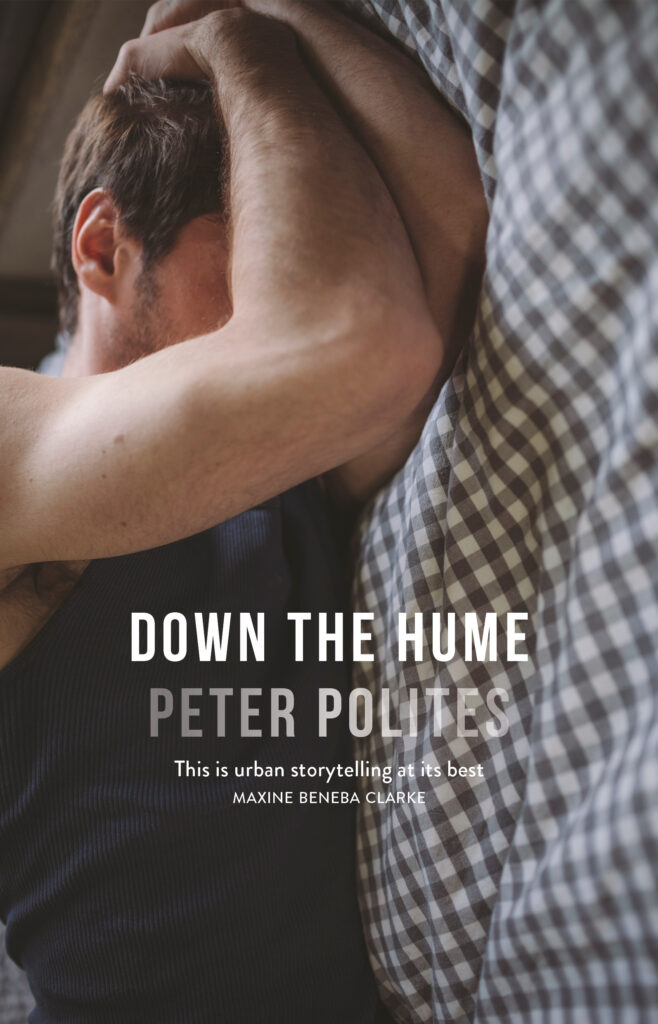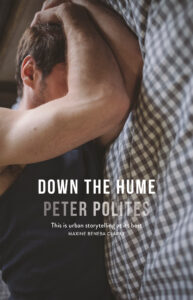Down The Hume, by Peter Polites

Cameron Colwell reviews Peter Polite’s debut novel Down The Hume.

Peter Polites’ Down the Hume is a rough and occasionally vicious exploration of Western Sydney, an area too often ignored in literature about the city. Committing hard to a staccato, neo-noir voice, Polites averts the homogenised blandness in much modern fiction with a fast-paced plot and a paranoiac protagonist who thinks in short, clipped sentences. Bux is a second-generation Greek man working as a nurse while caught in two obsessive relationships. One with Syrinapx, a brand of painkillers, and another with his physically abusive white boyfriend, ‘Nice Arms Pete.’
This is not the first Peter Polites noir story with a protagonist fitting these descriptors lusting over a Nice Arms Pete: This particular set-up was also used in Polite’s More Handsome than a Monkey, a short story that appeared in the 2014 anthology Stories of Sydney. Stories of Sydney was a collection born from SWEATSHOP, a writer’s movement in Western Sydney of which Polites is the associate director.
Like fellow SWEATSHOP writer Luke Carman’s An Elegant Young Man and a fair amount of stories from that collection, Down the Hume has a deep interest in the way that urban geography shapes people. Chapters named after streets focus just as much on the stratified locales of the novel just as much as they do on the people occupying them:
“The lockouts had hit Oxford Street hard. It was a ghost town till I got to Taylor Square. No messy chicks in halter dresses spewing in gutters. No young men wearing their good shirts and looking for a bad fight. Late-night kebab shops closed down, no tobacconists, no greasy pizza. Night owl convenience stores kept open on the backs of South-East Asian guys on 457 visas, being paid below-minimum wages.”
Deeply-felt separations from a Greek world where Bux’s father is known as ‘King of his Country with a Faggot for a Son” and a mainstream gay world characterised by middle-class pretension and physical vanity add to the growing sense of alienation felt through the novel, before the final chapter, which squarely discusses modern feelings of diaspora: “But were we citizens in the city? Or land-owning peasants in the village? We still read currawongs as friends of catastrophe while we sipped on VB shandies.”
The plot, while always entertaining, feels occasionally disjointed. Bux works, ogles men, visits his parents, and reflects on his upbringing. Anchoring this is a sense of something sinister accruing just out of Bux’s vision — a running suspicion that could be put down to his paranoid nature until Polites pulls off a twist that shoves everything before it into the light. The noir stylings beyond the general cynicism and a surreptitious, unseen crime building around Bux include Nice Arms Pete’s characterisation as a sort of male femme fatale, a convention Polites uses to frame the power dynamic between Bux and the (often white) men he desires. Nice Arms Pete, for instance, is described as:
“A wheat-fed kid and I saw him swimming in billabongs near a farmhouse. Sandy hair, skin still smooth but slightly sun-aged, and you could see clean living on him. The kind of Australian I could never be. In a red coat with a musket pointed at a native.”
Down the Hume is riveting and urgent and meaningfully anti-establishment. It makes the best of its dual status as a crime/thriller page-turner and a literary exploration of the structures of a city seen through a noir lens. It is a rare clear-eyed look at a portion of Australia generally only seen in mainstream media through bigoted propaganda and news programs mining inequality for ratings. It is also a visceral pleasure to read. It cannot be recommended enough.
[ad_2]


